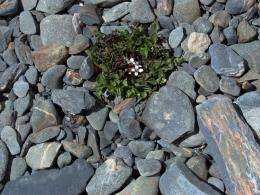March 6, 2012 report
Research team shows people are carrying invasive seeds to Antarctica

(PhysOrg.com) -- When thinking of invasive plants taking hold in a new environment, not many people would think of Antarctica; it’s cold and hostile and there aren’t many types of plants that could survive there. Yet, invasive species are invading the continent nonetheless and an international team of researchers led by Steven Chown of Stellenbosch University, in South Africa has found that up to twenty percent of visitors to Antarctica inadvertently carry seeds with them, leading to unpredictable changes in the once pristine environment. The team, as they explain in their paper in the Proceedings of the National Academy of Sciences, made this discovery by vacuuming gear brought by visitors during the summer of 2007-8.
Concerned that visitors to Antarctica might unknowingly be carrying seeds with them when they ventured to the mostly frozen continent, Chown and his team asked tourists, boat crews, researchers and others to submit to having their gear vacuumed before getting off the boat or plane. Each had their outer clothes vacuumed along with camera cases, Velcro connectors and boots and any other place tiny seeds might find to hitch a ride. Afterwards, they compiled their results and were surprised to find so many samples.
In all they checked 853 people, representing just two percent of those that made their way to Antarctica that summer. In that sample they found over 2,600 seeds and other plant parts that can grow in soil given the right conditions and that over half of those samples found were from plants that live in cold-climates, meaning they’d have a reasonable chance of surviving in Antarctica. They also found that researchers were bigger offenders than tourists, accounting for nearly twice as many seeds on average per person, but tourists outnumber researchers almost five to one. If the samples found represented averages, the team calculates that would mean some 70,000 seeds and plant parts were being carried into Antarctica during the period studied.
Unfortunately, things since that time have only grown worse. Not only do more people visit the continent every year, but global warming has made many parts of Antarctica much more vulnerable to new species gaining a foothold. The researchers note that several plants such as annual bluegrass have already begun taking over several parts of the continent, most specifically the Ronne, Amery and Ross ice shelves. They suggest that those that visit take a little more care in cleaning their gear before visiting, or Antarctica, like most other continents, will become a mish-mash of plants, insects, and eventually animal life, that bears little resemblance to a place once known as the most pristine on Earth.
More information: Continent-wide risk assessment for the establishment of nonindigenous species in Antarctica, PNAS, Published online before print March 5, 2012, doi: 10.1073/pnas.1119787109
Abstract
Invasive alien species are among the primary causes of biodiversity change globally, with the risks thereof broadly understood for most regions of the world. They are similarly thought to be among the most significant conservation threats to Antarctica, especially as climate change proceeds in the region. However, no comprehensive, continent-wide evaluation of the risks to Antarctica posed by such species has been undertaken. Here we do so by sampling, identifying, and mapping the vascular plant propagules carried by all categories of visitors to Antarctica during the International Polar Year's first season (2007–2008) and assessing propagule establishment likelihood based on their identity and origins and on spatial variation in Antarctica's climate. For an evaluation of the situation in 2100, we use modeled climates based on the Intergovernmental Panel on Climate Change's Special Report on Emissions Scenarios Scenario A1B [Nakićenović N, Swart R, eds (2000) Special Report on Emissions Scenarios: A Special Report of Working Group III of the Intergovernmental Panel on Climate Change (Cambridge University Press, Cambridge, UK)]. Visitors carrying seeds average 9.5 seeds per person, although as vectors, scientists carry greater propagule loads than tourists. Annual tourist numbers (∼33,054) are higher than those of scientists (∼7,085), thus tempering these differences in propagule load. Alien species establishment is currently most likely for the Western Antarctic Peninsula. Recent founder populations of several alien species in this area corroborate these findings. With climate change, risks will grow in the Antarctic Peninsula, Ross Sea, and East Antarctic coastal regions. Our evidence-based assessment demonstrates which parts of Antarctica are at growing risk from alien species that may become invasive and provides the means to mitigate this threat now and into the future as the continent's climate changes.
Journal information: Proceedings of the National Academy of Sciences
© 2011 PhysOrg.com
















